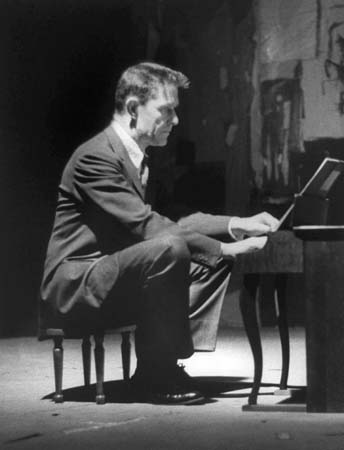I wrote yesterday about how Lady GaGa’s persona is essentially an imitation, philosophically and stylistically of Andy Warhol, even though the artists expressed themselves through different medium. At the end I made a broad conclusion that, as a culture, we are failing to move beyond Post-Modernism. I thought that I should explain more about why this -considering what we are going through ontologically- feels different with the advent of the digital age.

John Cage wrote very different music from Philip Glass, though both are post-modern composers
What is Post-Modernism after all? I think it is important to define these parameters while we explore why we are just moving into a new period of the same thing. Wikipedia’s article (quite like most tracts on Post-Modernism) struggles to define the period in clear cut terms. This is because this period featured an extreme breakdown of unified cultural movements. Instead of one broad cultural movement, with everyone expressing themselves in a similar manner (like Romanticism) we had a bunch of splintered movements, where groups of artists or even individuals created art of cultural significance entirely different from what another group may be doing.
From the Wikipedia Page: “The Compact Oxford English Dictionary refers to postmodernism as ‘a style and concept in the arts characterized by distrust of theories and ideologies and by the drawing of attention to conventions.'” We can see in much of Andy Warhol’s work that his whole schtick with pop-art was drawing attention to conventions of our consumption. His famous Campbell Soup Can piece highlights the forms of a simple every day object, our convention of eating canned soup. Likewise, when John Cage wrote 4:33, he composed a work that, though he stated was intended to force people to listen to what was around them actually brought attention to the convention of a concert setting. Audience members attending the work for the first time probably thought, “I paid good money to hear music, why has the pianist not begun to play!”
This definition works well, but it fails to tell us the definitive features that are common in all post-modern works. Maybe this is impossible, but I think that we can still find prevalent cultural trends even in a movement that “distrusts theories and ideologies.” The Standford Encylopedia of Philosophy has a long article that delves deeply into what the editors believe are important philosophical tenants of post-modernism, but I thought I would refer to just one of the sections to keep this a blog post as opposed to a doctoral thesis on culture.
In the article Hyperreality is discussed:
Hyperreality is closely related to the concept of the simulacrum: a copy or image without reference to an original. In postmodernism, hyperreality is the result of the technological mediation of experience, where what passes for reality is a network of images and signs without an external referent, such that what is represented is representation itself.
Now, it is important to stop before continuing and note that consumerism, especially in industrialized nations since World War II, has been one of the defining cultural movements in the post-modern period. The before the Internet period (especially before our slick new social networking, web 2.0 apps) was defined by consumption of objects. The idea in America was that to obtain a white picket fenced house in the suburb, buy a car and TV was what every family needed to be happy. This hasn’t particularly been supplanted since the advent of the compu-global-hyper-mega-net, but in some ways, it is in the background as we are now consuming information from and about each other
Consider the fact that in many industrialized nations over 10% of the population have a Facebook profile. In Iceland 46.89%(!) of the population has a Facebook profile. Last January, 1 in 4 Americans had a Myspace account. It is clear that webmasters have a huge amount to gain in profit from our consumption of each other. What happens in these short profiles about us, or in stream-of-consciousness-like “tweets” is we create of projection of ourselves based on what we would like other people to know, very much akin to a brief meeting and conversation with a stranger.
This distillation of the self is essentially a Hyperreality of people. When I read a person’s profile, it does not permit me to know them intimately as I would through working with, or befriending an individual. All I merely consume from that profile is the copy or image that the creator would like me to see, without reference to the true individual, their flaws, their dreams, their greatest accomplishments or their lowest low. Their being is not their profile, which is merely a simplified reflection on an electronic surface.
This is why our society has not moved beyond post-modernism and why, I believe we are ontologically stuck artistically with no direction. It would be wonderful for someone or something to come along and shake that up.